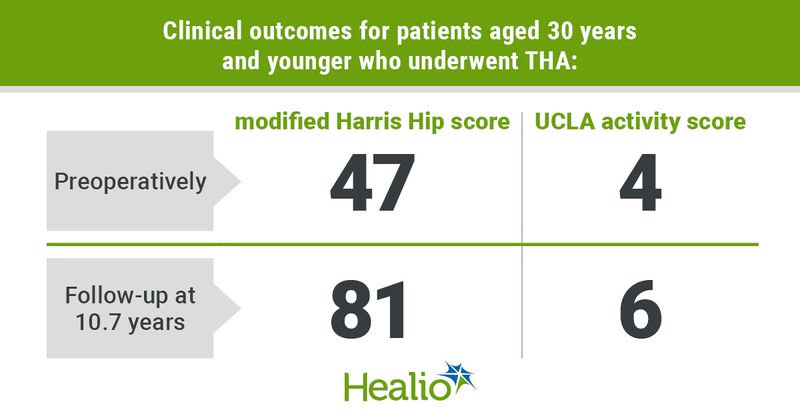Contemporary THA yielded improved clinical results for patients aged 30 years and younger
Key takeaways:
- Patients aged 30 years and younger who underwent THA had improved clinical outcomes at 10 years.
- THA may be a solution for this population when joint preservation is not feasible.
Results published in the Journal of Arthroplasty showed patients aged 30 years and younger who underwent contemporary total hip arthroplasty had improved clinical outcomes at 10 years with encouraging survivorship rates.
Researchers performed a retrospective analysis of 144 contemporary primary THAs with a highly crosslinked polyethylene acetabular bearing surface in 121 patients aged 30 years and younger (mean age of 23 years). They analyzed clinical outcomes, such as modified Harris Hip scores (mHHS), University of California Los Angeles (UCLA) activity scores, complications, polyethylene wear and implant survivorship.

With an average follow-up of 10.7 years, researchers found mHHS improved from 47 to 81 and UCLA scores improved from 4 to 6. The overall complication rate was 5.6%. Six hips (4.2%) required revision surgery for instability (n = 3) late infection (n = 1), liner dissociation (n = 1) and acetabular loosening (n = 1). However, researchers noted no revisions occurred after the first 6 years.
Researchers also found low mean linear (0.0438 mm/year) and volumetric (29.07 mm3/year) wear rates. They noted survivorship free from revision was 97.2 at 5 years, 95.8 at 10 years and 95.8 at 15 years, according to the study.
“THA in the very young can be challenging due to previous corrective surgeries, which may result in abnormalities of acetabular version, proximal femoral morphology, femoral alignment, and femoral version,” the researchers wrote in the study. “Based on the above outcomes and wear data, we remain optimistic that THA is a reasonable solution for this unique patient population when joint preservation procedures are not feasible or predictable,” they concluded.

